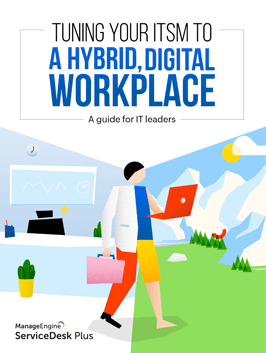In this chapter, we will talk about the top 10 best practices in change management based on IT recommendations.
10 change management best practices
Here are the best ways to approach change management.
1. Identify the types of changes:
Not all changes are the same. Changes have varying levels of priority and different requirements, as explained under the types of changes section. Therefore, it's important to first identify the kinds of changes that your organization might perform, and then create different change types to effectively roll them out.
2. Design processes for different change types:
Since different change types have their own unique requirements, you need to design unique processes to fulfill those needs. Using the same change process for all change types will only lead to unnecessary delays and incomplete change implementations.
Note: You can create different change workflows for each of your change types.
3. Define key roles and responsibilities:
Defining roles allows the change manager to delegate activities and responsibilities to others. Roles make it easier to manage changes, and they clearly define the activities that each person can perform.
4. Log, manage, and prioritize change proposals:
It's a best practice to have an organized way to log your changes, as well as manage and prioritize them in one place. With better visibility into your organization's changes, you can prioritize which changes need to be performed ahead of others.
5. Gain clear insights on the risks and impact of changes:
All changes need to go through risk and impact analysis to understand the change better and allocate the necessary resources. The risk and impact details should be added at the planning stage so the CAB has a clear picture of the change and can give their recommendation.
6. Put an effective approval mechanism in place:
Defining the approval process makes it easy to get the necessary permissions for a change to be implemented. It ensures that all key stakeholders are aware of changes and give their recommendation before a change is implemented. This helps curb unauthorized changes.
7. Communicate schedules and downtime with stakeholders:
Keeping stakeholders informed of planned changes reduces the number of incidents caused by changes. Delivering prompt information also ensures that no services are affected due to changes, and that the change can be carried out effectively. As a bonus, management is also happier when they're informed throughout the change life cycle.
8. Measure the progress and effectiveness of change implementations:
Keeping an eye on a change throughout the entire change life cycle ensures that nothing goes wrong and that the change is implemented according to the change plan. Measuring key metrics gives you a clear picture of how effective your change process is and also lets you identify areas you can improve.
9. Keep contingency plans in place:
You can never be too prepared, so it's always a good idea to plan for the worst-case scenario and come up with a backout plan during the change planning stage. This in-depth planning can mean the difference between a run-of-the-mill failed change and irreversible damage to your IT infrastructure.
10. Implement continual service improvement:
Although firefighting is a crucial function of change management, changes have a wider scope in your organization. Using changes to improve technology and processes, and thereby continually enhance your organization's ability to provide better services, is becoming an important function of change management.
Set up your own best practice change management process with ServiceDesk Plus
FAQs

Here are 10 IT change management best practices based on IT recommendations:
- 1. Identify the types of changes that your organization is likely to roll out
- 2. Design processes for the different change types of your organization
- 3. Define key roles and responsibilities
- 4. Log, manage, and prioritize change proposals
- 5. Put an effective approval mechanism in place
- 6. Communicate schedules and downtime with stakeholders
- 7. Measure the progress and effectiveness of change implementations
- 8. Keep contingency plans in place
- 9. Implement continual service improvement
- 10. Gain clear insights on the risks and impact of changes
Successful changes come with a few key elements that determine their path to success. Here are five elements that lead to successful changes:
- 1. Vision
- 2. Benefits
- 3. Sponsorship
- 4. Resources
- 5. Methodology
- 1. Be user-centric: All changes are essentially fueled by people—users, stakeholders, and technicians. Allow them to be at the forefront with proper communication, from the start of the change process.
- 2. Embrace digitization: As organizations are trodding on the path of digital transformation, it's important to strategize change plans Benefits: Design processes for the different change types of your organization
- 3. Sponsorship: Define key roles and responsibilities
- 4. Resources: Log, manage, and prioritize change proposals
- 5. Methodology: Put an effective approval mechanism in place






